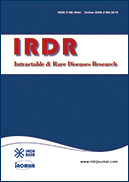Volume 9, Issue 4
Displaying 1-12 of 12 articles from this issue
- |<
- <
- 1
- >
- >|
Review
-
Article type: research-article
2020 Volume 9 Issue 4 Pages 187-195
Published: October 31, 2020
Released on J-STAGE: November 04, 2020
Advance online publication: July 09, 2020Download PDF (305K) -
Article type: review-article
2020 Volume 9 Issue 4 Pages 196-204
Published: October 31, 2020
Released on J-STAGE: November 04, 2020
Advance online publication: August 14, 2020Download PDF (360K) -
Article type: review-article
2020 Volume 9 Issue 4 Pages 205-216
Published: October 31, 2020
Released on J-STAGE: November 04, 2020
Advance online publication: August 24, 2020Download PDF (371K)
Original Article
-
Article type: research-article
2020 Volume 9 Issue 4 Pages 217-221
Published: October 31, 2020
Released on J-STAGE: November 04, 2020
Advance online publication: August 26, 2020Download PDF (1987K) -
Article type: research-article
2020 Volume 9 Issue 4 Pages 222-228
Published: October 31, 2020
Released on J-STAGE: November 04, 2020
Advance online publication: October 12, 2020Download PDF (1502K)
Case Report
-
Article type: case-report
2020 Volume 9 Issue 4 Pages 229-232
Published: October 31, 2020
Released on J-STAGE: November 04, 2020
Advance online publication: August 24, 2020Download PDF (562K) -
Article type: case-report
2020 Volume 9 Issue 4 Pages 233-246
Published: October 31, 2020
Released on J-STAGE: November 04, 2020
Advance online publication: August 24, 2020Download PDF (1166K) -
Article type: case-report
2020 Volume 9 Issue 4 Pages 247-250
Published: October 31, 2020
Released on J-STAGE: November 04, 2020
Advance online publication: September 04, 2020Download PDF (952K) -
Article type: case-report
2020 Volume 9 Issue 4 Pages 251-255
Published: October 31, 2020
Released on J-STAGE: November 04, 2020
Advance online publication: October 09, 2020Download PDF (1307K) -
Article type: case-report
2020 Volume 9 Issue 4 Pages 256-259
Published: October 31, 2020
Released on J-STAGE: November 04, 2020
Advance online publication: September 04, 2020Download PDF (357K) -
Article type: case-report
2020 Volume 9 Issue 4 Pages 260-262
Published: October 31, 2020
Released on J-STAGE: November 04, 2020
Advance online publication: October 09, 2020Download PDF (1482K)
Letter
-
Article type: letter
2020 Volume 9 Issue 4 Pages 263-265
Published: October 31, 2020
Released on J-STAGE: November 04, 2020
Advance online publication: October 09, 2020Download PDF (639K)
- |<
- <
- 1
- >
- >|
